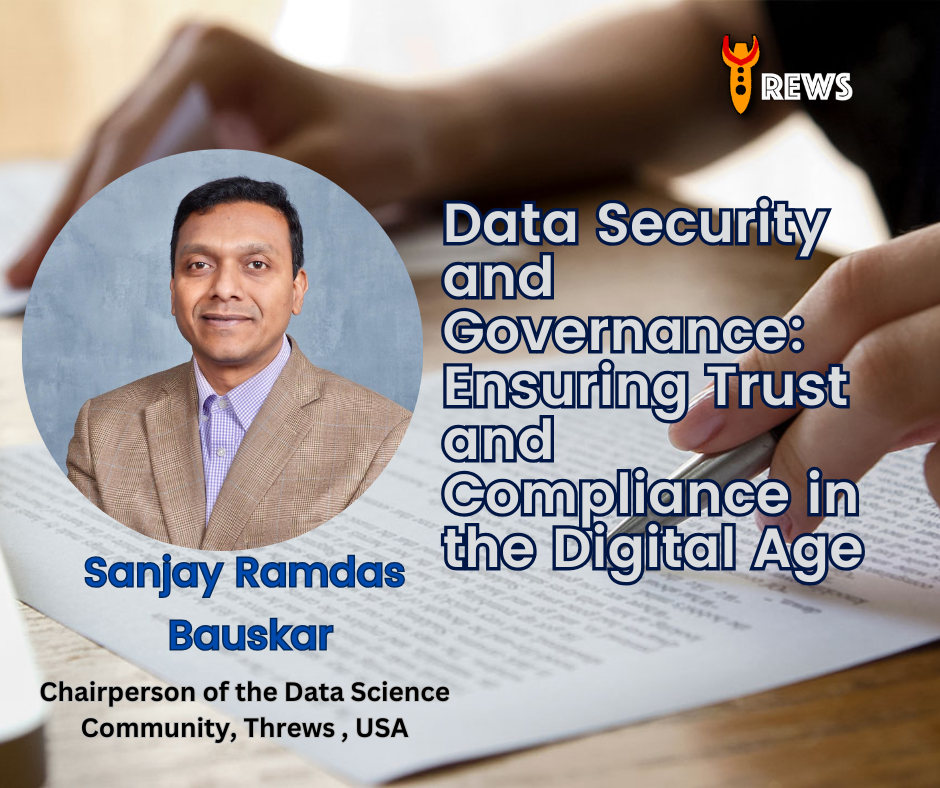Written by:
Sanjay Ramdas Bauskar
Chairperson of the Data Science Community, Threws , USA
Published on: Oct 25, 2024
In today’s digital world, data security and governance play a crucial role in protecting sensitive information from cyber threats while ensuring compliance with regulations. With increasing concerns over data breaches, privacy laws such as GDPR, CCPA, and HIPAA require organizations to adopt strict security measures and governance frameworks.
This blog explores the importance of data security and governance, the challenges organizations face, and best practices for establishing a secure and compliant data management strategy.
1. Understanding Data Security and Governance
Data security focuses on protecting data from unauthorized access, breaches, and cyber threats. It includes encryption, access control mechanisms, and secure storage policies.
Data governance, on the other hand, ensures that data remains accurate, accessible, and compliant with industry regulations. It involves data classification, policy enforcement, and lifecycle management to maintain integrity and usability.
Both are essential for organizations to safeguard their data assets while leveraging them for business growth.
2. Importance of Data Security and Governance
Organizations need a well-defined security and governance strategy to:
-
Prevent data breaches and unauthorized access
-
Comply with regulatory requirements such as GDPR, CCPA, HIPAA, and PCI-DSS
-
Maintain customer trust by ensuring data privacy
-
Avoid financial losses associated with legal penalties and cyber incidents
-
Improve data accuracy for better decision-making and analytics
3. Key Challenges in Data Security and Governance
Despite its importance, many organizations struggle with implementing data security and governance effectively due to:
-
Increasingly complex regulatory requirements
-
Data silos and lack of centralized governance
-
Growing cybersecurity threats, including ransomware and insider attacks
-
Lack of awareness among employees, leading to accidental data exposure
-
Rapid growth of data, making it difficult to manage securely
To overcome these challenges, businesses must adopt a proactive approach with clear policies, advanced security technologies, and continuous monitoring.
4. Best Practices for Data Security and Governance
To ensure effective data protection and compliance, organizations should implement:
-
Access Control and Data Classification: Restrict data access to authorized personnel based on sensitivity levels.
-
Encryption and Secure Storage: Protect data in transit and at rest using industry-standard encryption methods.
-
Regular Security Audits: Conduct vulnerability assessments and penetration testing to identify potential risks.
-
Identity and Access Management (IAM): Implement multi-factor authentication and role-based access control.
-
Data Lifecycle Management: Define retention policies and secure deletion of obsolete data.
-
Employee Training and Awareness: Educate staff about phishing attacks, social engineering, and security best practices.
-
Automated Data Governance Tools: Leverage platforms such as Collibra, Talend, and Informatica to streamline compliance management.
By integrating these practices, businesses can strengthen their security posture and enhance data governance effectiveness.
5. Emerging Trends in Data Security and Governance
The landscape of data security and governance is evolving with advancements in technology. Some of the key trends include:
-
Adoption of artificial intelligence and machine learning for threat detection and security automation
-
Implementation of zero trust architecture, following a “never trust, always verify” approach
-
Use of blockchain for ensuring data integrity and secure transactions
-
Automated compliance management solutions for real-time regulatory adherence
-
Security enhancements for edge computing and cloud environments to prevent unauthorized access
6. Conclusion
As cyber threats continue to evolve and regulatory requirements become more stringent, businesses must prioritize data security and governance. A strong security framework, combined with effective governance policies, helps organizations safeguard their data, remain compliant, and build trust with customers.
Organizations that proactively address security and governance challenges will be better positioned for long-term success in the digital economy.

